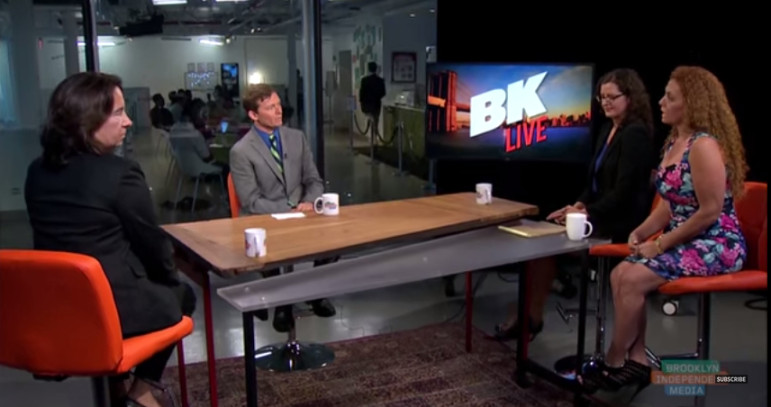
Brooklyn Independent Media
On the set of Bk Live, from left to right, were reporter Wendy Davis, Jarrett Murphy, Bronx Defenders legal director Marika Meis and Empire Bailbonds CEO Michelle Esquenazi.
About 1,000 times a week in New York City, a judge tells a defendant who is presumed innocent that he or she can pay for their freedom by putting up bail—an amount of money that will be forfeited if the defendant fails to show up for court. Because many people are arrested on fairly minor charges, they face low bails, but because many people who are arrested are poor, they still cannot afford them. This creates a situation in which many people are held on Rikers Island on minor charges and low bails, missing work, unable to care for their children and having their room and board footed by taxpayers.
Roughly half the people who get arrested in the city each year finish their case at arraignment, and of those that continue roughly two thirds are released on their own recognizance. Bail is set in about 30 percent of continued cases, and many people do make bail. But because of the high volume in the city’s court system, the minority of defendants who are jailed on bail encompasses a large number of people.
The bail problem has been on radar screens for awhile. City Limits produced the first comprehensive investigation of it in 2007. Human Rights Watch followed in 2010. Chief Judge Jonathan Lippman proposed an overhaul in 2013. In recent months, Council Speaker Melissa Mark-Viverito proposed a fund to pay bail for low-level defendants. Mayor de Blasio has implemented a more ambitious plan to create an alternative supervisory system for 3,000 defendants.
On Monday, Brooklyn Independent Media’s Bk Live asked City Limits to host a segment on the de Blasio plan and its promise and potential pitfalls. Reporter Wendy Davis, bail agent Michelle Esquenazi and Bronx Defenders legal director Marika Meis joined yours truly in the studio.








